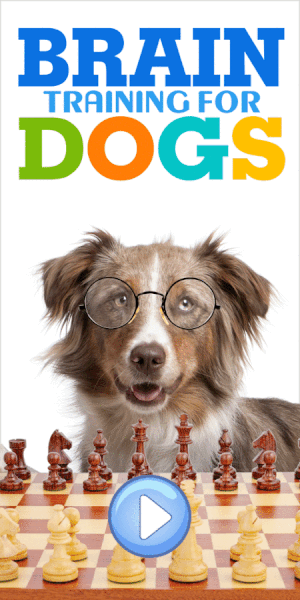Health
Beginners Guide to a Stress-free Way to Cut a Dogs Nails
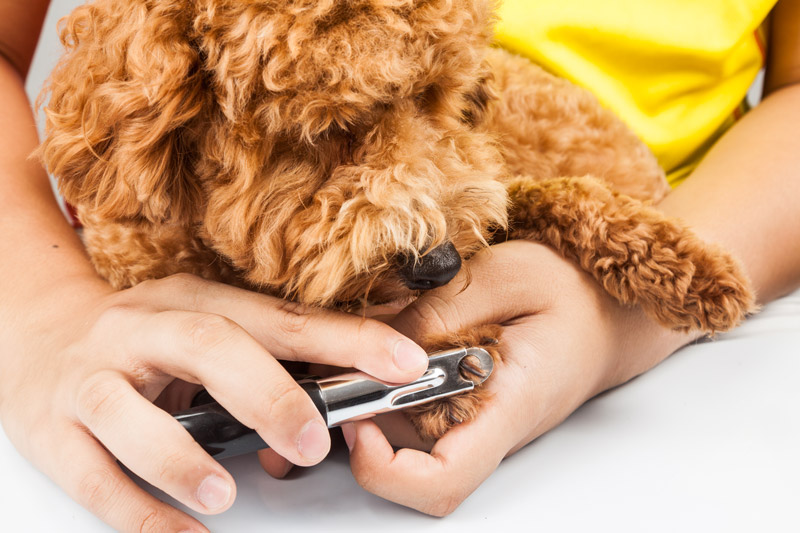
Many pet owners dread trimming their dogs nails; this is primarily due to past experience, where ones pet has given a terrifying yelp that has convinced you it is just not worth it to even try. On some occasions chasing your dog around the house just becomes to plain tiring, or perhaps a blood bath has ensued due to you not knowing precisely what you are doing; subsequently your dog proceeded to give you the silent treatment for an extended period of time.
I am here to tell you there is some hope. Below is a guide to safely trimming your dogs nails; I also included why it is of great importance to keep up on this, as well as signs that perhaps you may want to lead it to the professionals after all.
There are many different contraptions that will make your job a lot easier and make your canine companion have a stress and pain free experience.
Why a Dog’s Nail Care is Important
One of the most painful areas for any dog is the foot and nail area in particular. This shouldn’t be tender if your dog is well maintained, however accidents and general wear and tear do happen.
Injured nails are one of the most painful and bloody injuries a dog can suffer. Regular grooming and trimming greatly reduce the risk of such an occurrence. However, even well-trimmed nails can get torn from time to time.
What about a torn nail?
The first sign of a torn nail is typically bleeding around the toes. Dogs’ feet have a generous blood supply; they bleed quickly and extensively when injured. This speeds up when your dog is frightened, (as his blood pressure and heart rate are up, pumping blood more rapidly). If your dog is outside when they sustain this type of injury, infection can occur due to the possibility and ease of dirt entering the open wound.
Your goal at this point would be to stop the bleeding: Apply gauze pads with a clean rag, and wash the paw with warm water and soap. If the nail is torn you will want to trim carefully to prevent matters from worsening. You should additionally apply an antibiotic ointment and clean gauze; tape it firmly to your dog’s foot and then take them to the vet. This would most likely NOT be the time to learn how to trim your pups’ nails if you haven’t done so previously.
What if the nail is hanging off?
If the nail is dangling or hanging off, the nail does need to be extracted. The nail must be cut off at the place where the tear occurs, otherwise it can grow back deformed, as well as causing your dog a lot of pain. Your dog could develop a permanent limp from this type of issue; it is generally best for the vet to numb the area before removing the nail. Great care must be taken to prevent infection, which can travel from above the nail to the bone; this can even require amputation.
After ointment and gauze has been applied, the wound should be monitored for any kind of infection, such as discharge or swelling.
Paw care
Dogs’ feet can take a serious beating- from pounding his paws on the pavement (causing much friction) to receiving unkind blisters from the hot pavement or splinters and rocks from various terrains. You can rub Vitamin E on the pads of your pooches’ paws for relief, and be sure to consistently examine the bottoms of the feet, in particular for any debris or injuries.
Be cognizant of any signs of discomfort displayed by your furry friend; this can range from whining, to pulling his/her paws away, and to licking the paws or nipping at them.
What about the hair in-between their pads?
The hair in-between the pads should also be clipped. With medium to large dog breeds, it is important to keep the toe nails cut. The spaces between the pads can house dirt, burrs, fleas, ticks and mats to name a few. Your dog may have developed a habit of chewing on their feet, or the hair in between the foot pads.
You can trim the feet using a pair of blunt nosed baby fingernail scissors. Hold the foot up separating the pads with your fingers gently, while carefully trimming hair as close as possible to the pads with scissors.
Instructions: The Right Way to Trim Nails
Cutting your dog’s nails is certainly not just for appearances sake. This habit is vital for the health and comfort of man’s best friend. You can trim with a handheld cutting device provided your dog cooperates, or you can alternately use an electronic grinder to cut the nail just to the point where the nail starts to curve downward.
Caution!! Be extremely careful not to cut the “quick”; this area contains the nerves and blood cells in the nail area.
If your dog has white/clear nails, it is typically easy to look for this pink line that extends from the base of the nail down to the tip. Make sure to clip only below the pink line. If your dog has darker pigmented nails this may become a little more challenging, in relation to finding the quick. You can use a flashlight for assistance, and always remember to be conservative.
It is a good idea in all cases to keep a container of styptic powder available.
This product aids in the clotting of blood and can prevent a surprisingly rather bloody scene that will likely terrify you and your dog. Make sure to use a tool that you feel comfortable with as dogs remember pain, and next time will be more challenging. You can always leave this to the pro’s if you don’t feel confident; I also recommend watching some very helpful videos on YouTube, if you are more of a visual person.
If your dog is scared of this entire process, here are a few helpful steps you can try:
- Get your dog accustomed to seeing nail clippers. Act happy when you grab the clippers, and give your dog a treat. Repeat this several times a day for approximately 2 weeks.
- Train your dog to allow paw handling. Work your way down from touching your dog’s shoulder to his/her paw. Give each paw a soft squeeze, then apply pressure to the nail itself.
- Acquaint your dog with the sound of clippers. Open and close the clippers as you talk to your dog and give them a treat.
- Combine paw handling with use of the clippers. The goal here is to prepare your dog to tolerate the touch of clippers. Begin touching clippers to the nail; if your dog allows - touch his toe with clippers. If your dog becomes anxious take a break.
Clippers Vs. Grinders: Pros & Cons
PetMD recommends a guillotine style cutting apparatus for smaller dogs, plier-style for larger dogs; you can also use plain scissor-type clippers or a nail grinder.
Dog Nail Grinder
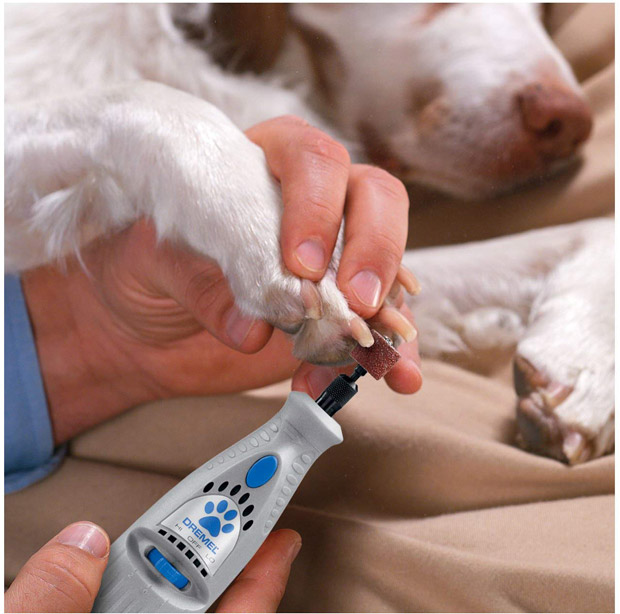
The nail grinder sands down the nail, it is typically painless, however the sound and vibration can scare your dog. This method does have the benefit of producing smooth, rounded nails rather than the sharp edges made by clippers.
The smoother and rounder your dog’s nails are the less likely it will be that your dog will damage furniture, hurt himself by scratching with rough nails, or get his /her nails snagged on something. The grinder is also good for thick nails that are difficult to clip.
A downside to this method is that you must have a source of electricity or use batteries to operate this device. You also may want to use the grinder outside and use a protective breathing device and eyewear. The dust can be an irritant and also cause an odor. You do still run the risk of hitting the quick. Have some dog treats handy to insert some happy memories with this activity.
Dremel 7300-PT 4.8V Pet Nail Grooming Tool
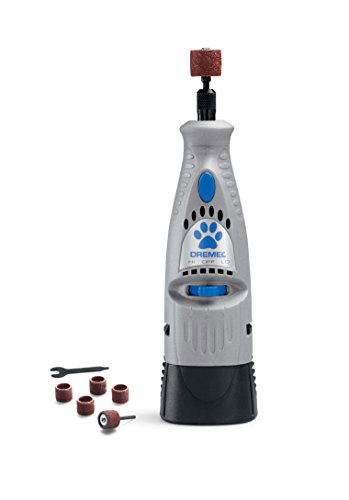
Rotary tool provides a safe, effective, less stressful alternative to clipping.
Dog Nail Clippers
Make sure to test clippers, ensuring that the blades are working correctly. You can also have your vet show you the correct way to proceed when clipping your dog’s nails. Remember that your dog may be very nervous; you don’t have to cut all the nails at once.
Guillotine-style clippers can crush a dog’s toe and the blades need to be replaced often. This style is not suitable for larger dogs as it isn’t strong enough to cut the nail off. Clippers are a good choice if you are on a budget, as they are low cost and they do not require electricity. There are plenty of different brands and styles out there so you will want to make sure you purchase some well-reviewed, quality clippers.
The downside to this method is that clippers/scissors can cut into the quick, and can also squeeze and pinch the quick causing pain. Nail breakage can occur, or splitting or cracking of the nail, especially if the blades are not very sharp.
Boshel Dog Nail Clippers
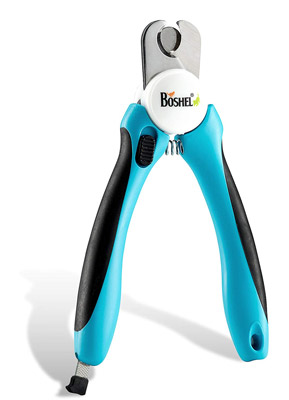
The Boshel pet nail clipper is an ergonomically designed Powerful and easy-to-use pet grooming tool, the nail trimmer is recommended by animal trainers, veterinarians, professional pet groomers.
When to Cut a Dog’s Nails
Not all dogs nails need to be trimmed, some are naturally worn down or flake away. The Bassett hound and Dachshund are two examples of dogs that are notorious for needing their nails to be kept relatively short.
You should typically trim nails anywhere from once a week to once a month. K9ofmine states that a dog’s front nails tend to grow faster than the back; you may not need to trim the rear as frequently.
Though you want to be cautious, cutting close to the quick does encourage the nails to shrink back. If a dog’s nails are extra-long: you may want to cut a little a time, do not cut them short all at once. Some dogs’ nails will curl under if they become too long, they can grow into a dog’s foot pads and cause infection and a great deal of pain and discomfort.
In the case of puppies: allowing your dogs nails to grow too long can also cause the toes to spread. This occurrence can put stress on the ankle joint and your dog can experience trouble walking around. Dogs with long nails are prone to scratching floors and people to name a few. If possible, begin to trim the nails when your dog is a puppy.
Start by clipping the very tips once a week and use two people if you find yourself overwhelmed. Place the paw in your hand and hold each toe with your index finger and thumb. Do not squeeze the toe. Once again make sure to avoid the quick, and if the nails are darker- only clip the tips weekly. Help your dog to feel relaxed; you can compare it to going and getting a pedicure or a day at the Spa.
Keep things serene, and a simple rule of thumb is to cut the nails just above the floor. You don’t want your dog slipping and sliding around; they do use their nails for traction. Also, pay attention to your dog’s body language, if they are yawning or pulling their paws away you may want to investigate the reasons behind this.
You can also spring for what resembles a doggy straight jacket, AKA a grooming hammock/harness to assist in keeping your buddy static.
Veterinarian Approved Dog Support Harness
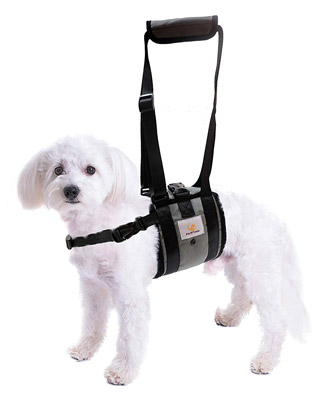
The handles are easy to adjust for maximum comfort, good posture for all dog owners regardles of their height. Making grooming easy.
Summary
Nail care, once again, is not something as responsible pet owners, we should ignore. The best course of action is to talk to your vet first, finding out what your specific dogs needs are in this realm.
If you are on a budget like many of us, do some research online- read some product reviews, as well as find out any breed specific information you can, taking into account your dog’s lifestyle and size. Make sure to keep some treats handy and get a friend to help you the first time around.
Take some time to get your dog comfortable with nail clippers and decide which type work for you and your dog. Make sure to have some clotting powder handy in case you accidently cut into the quick, don’t panic! Remember, when in doubt play it safe. If all else fails, a trip to the groomers could potentially save you money, in the unfortunate event that your dog develops an injury due to untrimmed nails or an infection.
- Topics:
- Health

